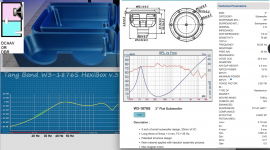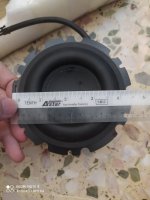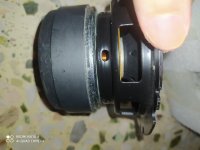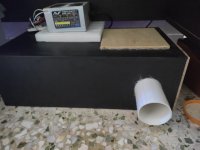Hi everyone.
I am doing some experiments with the small 3 inch "jbl atlas"
I am trying to build a small subwoofer but here is a thing.
I tried it in a 6l enclosure tuned to somewhere below 40hz (I know it is not right) but it really surprised me with organ and electronic music. I really gets super low for its size and doesn't reach anywhere near xmax at lower frequency but the problem is that higher kick bass that I really like doesn't play really well and it even bottoms out on higher frequency.
I would like to have a small subwoofer that plays super low but I would also like it to be decent with rock type music. So can I use something like in this video
HexiBox v.3 featuring Lotmaxx SC-10 - YouTube
Where for example first "active" chamber is tuned properly around the resonance of the driver but then the port fires into the second "passive" chamber that is tuned to something lower. And the idea is that when the first chamber starts unloading the second one will take over.
So would that work? And how would I find the tuning and volume ratios of each chamber?
I am also open to using some eq if needed.
I am doing some experiments with the small 3 inch "jbl atlas"
I am trying to build a small subwoofer but here is a thing.
I tried it in a 6l enclosure tuned to somewhere below 40hz (I know it is not right) but it really surprised me with organ and electronic music. I really gets super low for its size and doesn't reach anywhere near xmax at lower frequency but the problem is that higher kick bass that I really like doesn't play really well and it even bottoms out on higher frequency.
I would like to have a small subwoofer that plays super low but I would also like it to be decent with rock type music. So can I use something like in this video
HexiBox v.3 featuring Lotmaxx SC-10 - YouTube
Where for example first "active" chamber is tuned properly around the resonance of the driver but then the port fires into the second "passive" chamber that is tuned to something lower. And the idea is that when the first chamber starts unloading the second one will take over.
So would that work? And how would I find the tuning and volume ratios of each chamber?
I am also open to using some eq if needed.
Its likely the little Sub is just unloading.
So a 24 dB highpass filter set a few Hz below tuning frequency
will reduce unloading.
Otherwise called over excursion filter, sub sonic filter etc etc.
I tended to find sealed enclosures more accurate for all music genres.
These elaborate ported enclosures trying to squeeze bass out of tiny
speakers. Starts to become a gimmick.
If you want to control unloading you either dont use a reflex box.
Or use a actual driver with a lower Fs that can actually be tuned lower.
And still use a highpass protection filter.
Once you hit resonance and the huge impedance spike.
That is the end of the road. Magical enclosures with
millions of port chambers dont remove impedance peaks.
You just move up to larger drivers that have lower Fs
Such as a 8" or 10"
So a 24 dB highpass filter set a few Hz below tuning frequency
will reduce unloading.
Otherwise called over excursion filter, sub sonic filter etc etc.
I tended to find sealed enclosures more accurate for all music genres.
These elaborate ported enclosures trying to squeeze bass out of tiny
speakers. Starts to become a gimmick.
If you want to control unloading you either dont use a reflex box.
Or use a actual driver with a lower Fs that can actually be tuned lower.
And still use a highpass protection filter.
Once you hit resonance and the huge impedance spike.
That is the end of the road. Magical enclosures with
millions of port chambers dont remove impedance peaks.
You just move up to larger drivers that have lower Fs
Such as a 8" or 10"
Hi everyone.
I am doing some experiments with the small 3 inch "jbl atlas"
I am trying to build a small subwoofer but here is a thing.
I tried it in a 6l enclosure tuned to somewhere below 40hz (I know it is not right) but it really surprised me with organ and electronic music. I really gets super low for its size and doesn't reach anywhere near xmax at lower frequency but the problem is that higher kick bass that I really like doesn't play really well and it even bottoms out on higher frequency.
I don't believe your issues have anything to do with unloading or tuning frequencies. A drum kick is a very violent action. Your driver has simply reached it's Xmech. Oversimplified: a kick-drum membrane and a speaker diaphragm are not that dissimilar. When the beater hits the membrane it moves it, the hit sharply displacing a volume of air. All things being equal: your driver is required to displace a similar volume of air. However, a kick drum diaphragm is 22" and your speak driver is just 3".
Like I said, over simplified.
At frequencies higher than the tuning frequency, the port does not keep cone excursion under control. It seems that this is the problem. A kick drum has got strong output above 40 Hz. Most rock music does not require extension below 45 Hz, so you can tune the port higher.
Can you measure the Thiele Small parameters? These parameters allow you to run simulations in WinISD, which gives you insight in power handling vs frequency and maximum output.
As you are open to EQ, the easy and expensive solution is to start with a larger woofer woofer like the TangBand W6-1139 and stuff it into the same 6 L enclosure, with the port closed off.
Can you measure the Thiele Small parameters? These parameters allow you to run simulations in WinISD, which gives you insight in power handling vs frequency and maximum output.
As you are open to EQ, the easy and expensive solution is to start with a larger woofer woofer like the TangBand W6-1139 and stuff it into the same 6 L enclosure, with the port closed off.
Last edited:
I would like to have a small subwoofer that plays super low but I would also like it to be decent with rock type music.
With 3" drivers?
That's quite a challenge.
Even Bose went with larger drivers for the woofer modules for their AM series of subwoofers.
You'll probably need to use a higher-order system (like 8th order BP) if you want to reduce cone excursion even more within the passband, but that's a more complex build to do and get right.
thanks for all the feedback guys.
This is not supposed to be super audiophile woofer. This is just a fun/practice project...
I have this woofer from before. It was actually my first ever "subwoofer"
The driver seems to be really popular on the YouTube for its excursion. As far as I know it was used in some old jbl/Harman docking stations and PC speakers.
I found some parameters but I don't know how accurate thay are because I can't measure them myself.
Qts 0.49
Vas 0.049 ft3
Fs 65.27 hz
Re 4.13 ohm
Le 0.72 mh
Xmax 5.0 mm
Z 49.79
Qms 5.91
Qes 0.53
Spl 80.48 db
Pe 30.0 w
BL 3.77
Dia 5.90 cm
Sd 27.0 cm2
That is all I have been able to get if it is accurate.
I actually tried simulating it and recommended "optimal" box was around 4l and tuned to mid 50s if I remember correctly.
I want to at least get a little bit lower if possible without having a box that is like 10x the size of the normal one.
Oh and yes in that "super low" tuned box problem wasn't the lows. Lows actually played extremely well for its size.
Problem was that it was unloading at fs of the driver (around 50-60 hz) so if I could keep that low frequency output but just control the driver better that would be great.
If not I will just tune it higher.
This is not supposed to be super audiophile woofer. This is just a fun/practice project...
I have this woofer from before. It was actually my first ever "subwoofer"
The driver seems to be really popular on the YouTube for its excursion. As far as I know it was used in some old jbl/Harman docking stations and PC speakers.
I found some parameters but I don't know how accurate thay are because I can't measure them myself.
Qts 0.49
Vas 0.049 ft3
Fs 65.27 hz
Re 4.13 ohm
Le 0.72 mh
Xmax 5.0 mm
Z 49.79
Qms 5.91
Qes 0.53
Spl 80.48 db
Pe 30.0 w
BL 3.77
Dia 5.90 cm
Sd 27.0 cm2
That is all I have been able to get if it is accurate.
I actually tried simulating it and recommended "optimal" box was around 4l and tuned to mid 50s if I remember correctly.
I want to at least get a little bit lower if possible without having a box that is like 10x the size of the normal one.
Oh and yes in that "super low" tuned box problem wasn't the lows. Lows actually played extremely well for its size.
Problem was that it was unloading at fs of the driver (around 50-60 hz) so if I could keep that low frequency output but just control the driver better that would be great.
If not I will just tune it higher.
FYI/FWIW, I calc a ~3.64 L/49.7 Hz max flat BR with 0.5 ohms series resistance [Rg = ~0.54 Qts'] to account for wiring losses and requires a 1.5" dia. x 13.31" to get a ~18 m/s vent mach at its Xmax limited 8 W.
This acoustically large vent should go a long ways to controlling it down low till it exceeds Xmax a bit.
This acoustically large vent should go a long ways to controlling it down low till it exceeds Xmax a bit.
Attachments
The box you linked in the OP is called a DBR (Double Bass Reflex) the response does not appear to be what you are looking for- it drops like a rock below the peak (35dB/octave!), and -10dB (less than half as loud) above.t
I found some parameters but I don't know how accurate thay are because I can't measure them myself.
Qts 0.49
Vas 0.049 ft3
Fs 65.27 hz
Re 4.13 ohm
Le 0.72 mh
Xmax 5.0 mm
Z 49.79
Qms 5.91
Qes 0.53
Spl 80.48 db
Pe 30.0 w
BL 3.77
Dia 5.90 cm
Sd 27.0 cm2
I actually tried simulating it and recommended "optimal" box was around 4l and tuned to mid 50s if I remember correctly.
I want to at least get a little bit lower if possible without having a box that is like 10x the size of the normal one.
Oh and yes in that "super low" tuned box problem wasn't the lows. Lows actually played extremely well for its size.
Problem was that it was unloading at fs of the driver (around 50-60 hz) so if I could keep that low frequency output but just control the driver better that would be great.
If not I will just tune it higher.
Full range Double Bass Reflex (DBR) w/FaitalPro 3FE20
Excursion is at minimum at Fb, then rises dramatically about 1/3 octave above FB in a bass reflex, hence the higher kick bass you like doesn't play really well and it even bottoms out on higher frequency in an oversized cabinet tuned below 40Hz.
Like Brian mentioned, a higher-order system (like 8th order BP) would reduce cone excursion more within the passband.
Or simply use a 1.5 L box with an Fb around 65Hz, let the little cone do what it wants ;^)
Art
Attachments
Hi everyone.
I am doing some experiments with the small 3 inch "jbl atlas"
I am trying to build a small subwoofer but here is a thing.
I tried it in a 6l enclosure tuned to somewhere below 40hz (I know it is not right) but it really surprised me with organ and electronic music. I really gets super low for its size and doesn't reach anywhere near xmax at lower frequency but the problem is that higher kick bass that I really like doesn't play really well and it even bottoms out on higher frequency.
I would like to have a small subwoofer that plays super low but I would also like it to be decent with rock type music. So can I use something like in this video
HexiBox v.3 featuring Lotmaxx SC-10 - YouTube
Where for example first "active" chamber is tuned properly around the resonance of the driver but then the port fires into the second "passive" chamber that is tuned to something lower. And the idea is that when the first chamber starts unloading the second one will take over.
So would that work? And how would I find the tuning and volume ratios of each chamber?
I am also open to using some eq if needed.
i had the same thinking and the idea as what you are trying to do past few months ... Had a pair of apple homepod 4inch woofers with lots of excursion to play around firstly attempt to use it in ported enclosure for subwoofer duty but it bottoms out too easily then later shift to 4th order bandpass the excursion relieved a little but still bottom out occasionally ... and the unit used for trial and error subwoofer duty now had a bad smell on the voice coil compared to the one keeping for spare and not used ... finally i decided to assign them as full range duty ... lesson learned ... small driver with massive excursion dont do well for bass
Attachments
The TB W3-1876S is a marvel 3" sub for an alternative. I placed it in a 4th order bandpass with the Peerless 830878 as the exit PR. About a 5" cube, 30W is reasonable, and sounds very good. I call it the Goosebump. I made 2 in a dual opposed setup, and my 13'x15' LR suits it well.
Wolf
Wolf
Just to update you all.
I did some research and decided to go for a regular ported box tuned to somewhere around 45 hz.
It seem more than enough for small "subwoofer" which is probably gonna be used as a PC subwoofer together with some small 2 inch full range speakers.
Thanks for all the feedback guys. This is a learning/practice project and not something that is going to be my main system.
I did some research and decided to go for a regular ported box tuned to somewhere around 45 hz.
It seem more than enough for small "subwoofer" which is probably gonna be used as a PC subwoofer together with some small 2 inch full range speakers.
Thanks for all the feedback guys. This is a learning/practice project and not something that is going to be my main system.
- Home
- Loudspeakers
- Subwoofers
- Should I use dual chamber ported enclosure for mini subwoofer ???



